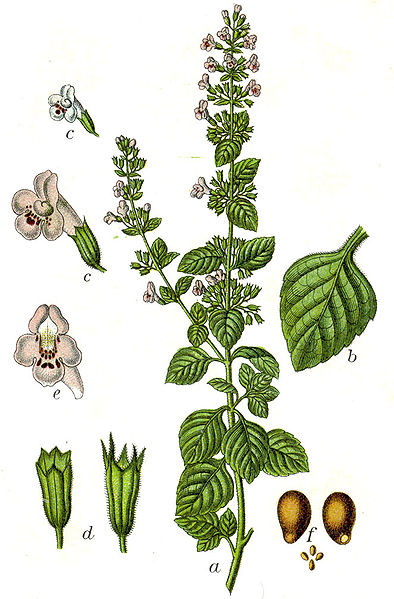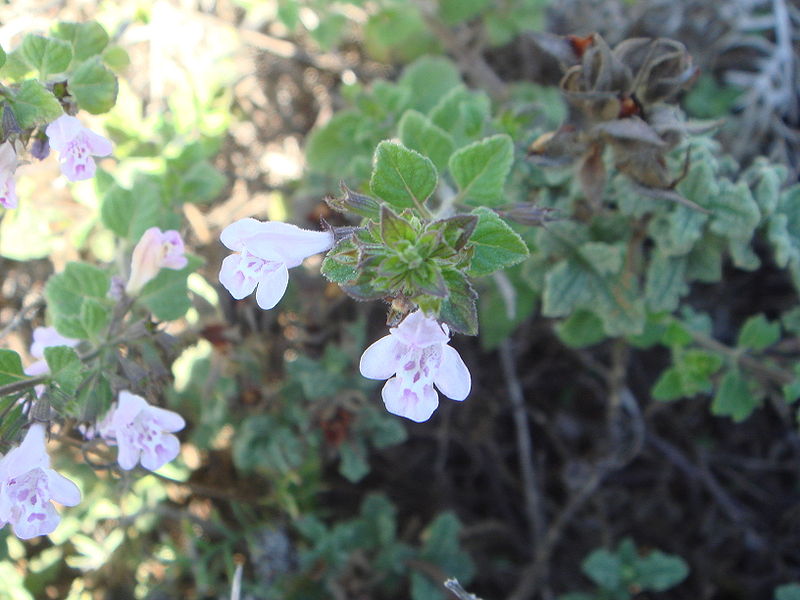 |
|
http://commons.wikimedia.org/wiki/File:Calamintha_officinalis_Sturm53.jpg |
 |
| http://commons.wikimedia.org/wiki/User:Xemenendura |
Translate this page:
Summary
Physical Characteristics

 Calamintha sylvatica is a PERENNIAL growing to 0.6 m (2ft) by 0.5 m (1ft 8in).
Calamintha sylvatica is a PERENNIAL growing to 0.6 m (2ft) by 0.5 m (1ft 8in).
See above for USDA hardiness. It is hardy to UK zone 6 and is not frost tender. It is in flower from July to September, and the seeds ripen from September to October. The species is hermaphrodite (has both male and female organs) and is pollinated by Bees, insects.
It is noted for attracting wildlife.
Suitable for: light (sandy) and medium (loamy) soils and prefers well-drained soil. Suitable pH: mildly acid, neutral and basic (mildly alkaline) soils and can grow in very alkaline soils.
It can grow in semi-shade (light woodland) or no shade. It prefers dry or moist soil.
UK Hardiness Map
US Hardiness Map
Synonyms
C. ascendens. C. baetica. C. officinalis. C. sylvatica ascendens. Satureia ascendens.
Plant Habitats
Woodland Garden Dappled Shade; Cultivated Beds;
Edible Uses
Edible Parts:
Edible Uses: Condiment Tea
A sweet and aromatic herb tea is made from the leaves[200]. Very refreshing[4, 200]. Leaves - used as a flavouring in cooked dishes[177]. Pleasantly pungent and strongly aromatic, the flavour is said to resemble a cross between mint and marjoram[183].
References More on Edible Uses
Medicinal Uses
Plants For A Future can not take any responsibility for any adverse effects from the use of plants. Always seek advice from a professional before using a plant medicinally.
Aromatic Diaphoretic Expectorant Stomachic
Calamint was commonly used as a medicinal herb in medieval times, though is little used by modern herbalists[238]. It has very similar properties to lesser calamint (C. nepeta) though is milder in its actions[238]. It is sometimes cultivated as a medicinal herb for household use. The whole plant is aromatic, diaphoretic and expectorant[4]. The leaves are harvested in July as the plant comes into flower and are dried for storage[4]. An infusion is beneficial in cases of fevers, flatulent colic and weaknesses of the stomach[4], it is also used to treat depression, insomnia and painful menstruation[238]. Its expectorant action makes it a good cough and cold remedy and it is of value for treating mild respiratory infections[254]. It is best mixed with other herbs, especially yarrow (Achillea millefolium) and Thyme (Thymus vulgaris)[254]. Calamint should not be prescribed for pregnant women since in excess it can cause a miscarriage[238].
References More on Medicinal Uses
The Bookshop: Edible Plant Books
Our Latest books on Perennial Plants For Food Forests and Permaculture Gardens in paperback or digital formats.

Edible Tropical Plants
Food Forest Plants for Hotter Conditions: 250+ Plants For Tropical Food Forests & Permaculture Gardens.
More

Edible Temperate Plants
Plants for Your Food Forest: 500 Plants for Temperate Food Forests & Permaculture Gardens.
More

More Books
PFAF have eight books available in paperback and digital formats. Browse the shop for more information.
Shop Now
Other Uses
References More on Other Uses
Cultivation details
Succeeds in a well-drained dry to moist neutral to alkaline soil and a sunny position[1]. Likes semi-shade[200]. Succeeds in a woodland garden[200]. Bees love the flowers of this plant[K].
References Carbon Farming Information and Carbon Sequestration Information
Temperature Converter
Type a value in the Celsius field to convert the value to Fahrenheit:
Fahrenheit:
The PFAF Bookshop
Plants For A Future have a number of books available in paperback and digital form. Book titles include Edible Plants, Edible Perennials, Edible Trees,Edible Shrubs, Woodland Gardening, and Temperate Food Forest Plants. Our new book is Food Forest Plants For Hotter Conditions (Tropical and Sub-Tropical).
Shop Now
Plant Propagation
Seed - sow spring in a greenhouse and only just cover the seed. It usually germinates in 2 weeks at 21°c[138]. Prick out the seedlings when they are large enough to handle and, if they grow sufficiently, plant them out into their permanent positions in the summer otherwise wait until the following spring. Division in spring. Very easy, larger clumps can be planted direct into their permanent positions. It is best to pot up smaller clumps and grow them on in a cold frame until they are well rooted before planting them out in the summer. Basal cuttings in May or June. They should be rooted in a sandy compost[245]. Harvest the shoots when they are about 10 - 15cm long with plenty of underground stem. Pot them up into individual pots and keep them in light shade in a cold frame or greenhouse until they are rooting well. Plant them out in the summer.
Other Names
If available other names are mentioned here
Native Range
TEMPERATE ASIA: Iran (north), Lebanon, Turkey, Russian Federation-Ciscaucasia (Ciscaucasia), Armenia, Azerbaijan, Georgia, Russian Federation (Dagestan) EUROPE: United Kingdom (south), Austria, Switzerland, Hungary, Ukraine, Albania, Bulgaria, Greece, Italy (incl. Sicily), Romania, Serbia, France (incl. Corsica) AFRICA: Algeria (north)
Weed Potential
Right plant wrong place. We are currently updating this section.
Please note that a plant may be invasive in one area but may not in your area so it's worth checking.
Conservation Status
IUCN Red List of Threatened Plants Status :

Growth: S = slow M = medium F = fast. Soil: L = light (sandy) M = medium H = heavy (clay). pH: A = acid N = neutral B = basic (alkaline). Shade: F = full shade S = semi-shade N = no shade. Moisture: D = dry M = Moist We = wet Wa = water.
Now available:
Food Forest Plants for Mediterranean Conditions
350+ Perennial Plants For Mediterranean and Drier Food Forests and Permaculture Gardens.
[Paperback and eBook]
This is the third in Plants For A Future's series of plant guides for food forests tailored to
specific climate zones. Following volumes on temperate and tropical ecosystems, this book focuses
on species suited to Mediterranean conditions—regions with hot, dry summers and cool, wet winters,
often facing the added challenge of climate change.
Read More
Expert comment
Author
Bromf.
Botanical References
17200
Links / References
For a list of references used on this page please go here
Readers comment
| Add a comment |
|
If you have important information about this plant that may help other users please add a comment or link below. Only comments or links that are felt to be directly relevant to a plant will be included. If you think a comment/link or information contained on this page is inaccurate or misleading we would welcome your feedback at [email protected]. If you have questions about a plant please use the Forum on this website as we do not have the resources to answer questions ourselves.
* Please note: the comments by website users are not necessarily those held by PFAF and may give misleading or inaccurate information.
To leave a comment please Register or login here All comments need to be approved so will not appear immediately.
|
Subject : Calamintha sylvatica
|
|
|
|